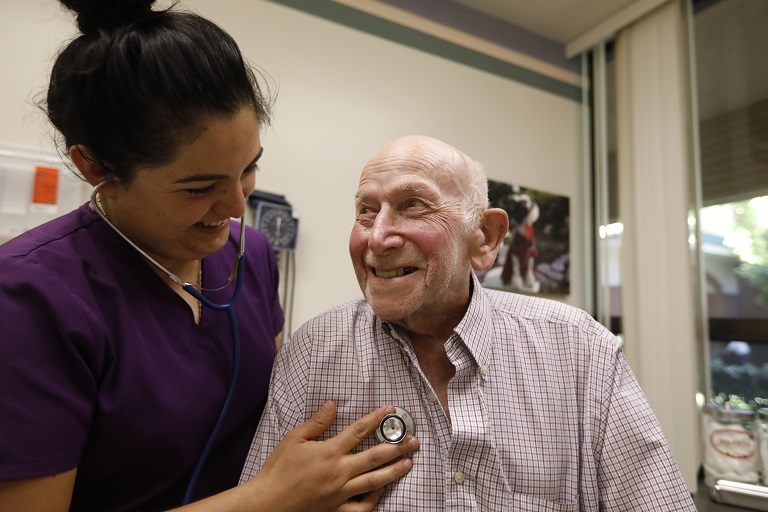Telehealth + In-Person Visits Improve Health
Using telehealth to supplement in-person healthcare visits can reduce hospital admissions and improve care, according to a study by AccentCare, which provides post-acute healthcare in 31 states.
The study looked at patient data and patient survey results to determine the effects of virtual healthcare plus in-person care (hybrid model) versus in-person care alone (traditional model) in post-acute home health care. The increase in telehealth use during the pandemic sparked the study, which was conducted in 2020.
A recent McKnight’s Senior Living article shared a synopsis from a webinar that AccentCare presented to the National Association for Home Care & Hospice. The study report itself, “Telehealth Improves Patient Outcomes and Overall Care Experience,” discussed the methods and results.
The research focused on Medicare Advantage beneficiaries in Texas, studying 295 hybrid model patients and 860 traditional model patients. A registered nurse conducted 159 telephone surveys. Outcome measures included five activities of daily living (ADLs) that are part of the home health OASIS (Outcome Assessment Information Set) assessment metrics.
Hybrid Model Improvements
Results include several findings to support the hybrid model of care:
-
Reduced Hospital Admissions: Only 6.5% of patients who received care through the hybrid model were admitted to the hospital within 30 days after starting home health care, versus 10.1% of patients who received only traditional visits. Of those admitted to the hospital within 60 days, 9.2% received hybrid care, and 13.3% received traditional care.
-
Improved Medication Management: Medication management was substantially better (+16%) for patients in the hybrid model than for those in the traditional model.
-
Improved Pain Management: The hybrid model yielded 11.4% improvement in pain that interferes with a patient’s activity or movement.
-
Improved ADLs: Collectively, five OASIS metrics showed a 6.7% improvement in patients who received care through the hybrid model. In addition to the medication management and pain management outcomes described above, the hybrid model brought improvements in ambulation (3.2%), dressing the upper body (2.6%), and transferring (1.7%).
-
Patient Satisfaction: Patients asked to rate their level of satisfaction with their care gave similar answers: 96% were satisfied with the hybrid care model, and 95% were satisfied with the traditional care model.
While the study did not investigate costs, the authors wrote that the study also “points to the opportunity for reduced costs of care.” The McKnight’s Senior Living article noted that telehealth saved on costs like personal protective equipment and staff transportation. The article also said that AccentCare tied telehealth to effective wound care, physical therapy, and speech therapy.
Next Steps
The AccentCare report concluded with a call to action to further explore the following telehealth opportunities:
-
“Enable collaboration with the patient’s hospital or skilled nursing facility for virtual bedside visits and to manage care transitions.
-
Provide a means for physicians to participate remotely in the care process to assist in completing virtual visits along with supporting manual procedures when necessary.
-
Actively involve family members in care discussions if they cannot be present during the virtual visit with the patient.
-
Engage with assisted living communities to provide technical capabilities to complete virtual visits.
-
Provide a means to work with care navigators to enhance self-care and support value-based care.”
Read the full report, “Telehealth Improves Patient Outcomes and Overall Care Experience.”
LeadingAge Annual Meeting + EXPO Session on Telehealth
To learn more, be sure to attend Technologies We Need Now More Than Ever, a session at the LeadingAge Annual Meeting + EXPO on Monday, Oct. 25, 2021, at 8 a.m.
Join three tech experts and a provider to explore how they leveraged telehealth and other technology solutions to fight COVID, and learn about the role these vital technologies could play in a post-COVID world. You will learn how telehealth can promote better preventative health, how a resident/family engagement solution can help you create a connected care community, and how you can make key decisions using the data you generate each day.

Most Recommended
October 15, 2025
 Shutdown Week Three: Impact of Ongoing Closure on Affordable Housing
Shutdown Week Three: Impact of Ongoing Closure on Affordable Housing
December 10, 2025
Fiscal Year (FY) Funding 2026
October 07, 2025
Immigrant Workforce Matching Program Brings Workforce Relief
Recently Added
December 19, 2025
House Moves Forward on Affordable Housing Reforms
December 19, 2025
White House Cannabis EO Paves Way for Research, Access
December 19, 2025
LeadingAge Urges DHS to Maintain "Public Charge" Guardrails
December 18, 2025



